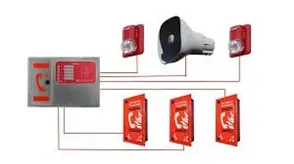Emergency Communication System
- Our Services Include:
- Complete Emergency Communication System Design
We design and deploy integrated emergency communication systems (ECS) that provide clear, immediate alerts and instructions during critical events such as fires, active threats, chemical leaks, and natural disasters. - Voice Evacuation & Mass Notification Integration
Systems designed for real-time voice announcements and automated emergency alerts. Integrated with fire alarms, public address systems, digital signage, and mass notification platforms. - Multi-Channel Emergency Alerting
Enable communication through multiple redundant channels—PA speakers, SMS, mobile apps, desktop alerts, sirens, LED boards, and two-way radios—to ensure messages reach everyone promptly. - Emergency Call Stations & Intercoms
Installation of indoor and outdoor emergency call points, intercom stations, and panic buttons to provide immediate contact with security or emergency services. - Building-Wide Audio & Visual Notification Systems
Deploy audio-visual devices such as strobe lights, sirens, speaker clusters, and warning beacons across large facilities, ensuring alerts are visible and audible in all areas. - IP-Based & Networked ECS Solutions
provide modern, IP-based emergency systems that integrate with existing IT and communication networks, allowing centralized control and remote triggering of alerts. - Pre-Recorded Emergency Messaging
Custom programming of pre-approved emergency messages based on incident types—fire, active shooter, weather alerts, evacuation, shelter-in-place, and lockdowns. - Fail-Safe Redundancy & Power Backup
Systems engineered with battery backups, failover control panels, and redundant communication paths to ensure operation even during power outages or network failures. - Compliance with Regulatory Standards
ECS systems designed in compliance with NFPA 72, UL 2572, OSHA, ADA, and local authority (AHJ) requirements—ensuring legal and functional readiness.
- Our Design Process
- Risk & Hazard Assessment
Conduct a detailed evaluation of your facility to identify potential emergency scenarios, occupant types, building layout, and communication gaps. - System Planning & Architecture Design
Develop a tailored ECS plan that defines message types, alert zones, audio/visual device placement, triggering mechanisms, and escalation protocols. - Technology Selection & Integration Strategy
Select the best-fit technologies—PA systems, fire alarm integration, mobile alerts, control panels, etc.—and plan how the system will integrate with existing safety infrastructure. - Zoning & Alert Routing Setup
Configure alerts to be targeted (per floor, department, or hazard area) or facility-wide depending on the situation. Helps avoid unnecessary panic and improve response effectiveness. - System Testing & Compliance Validation
Perform system-wide functional tests, volume/intelligibility checks, failover tests, and validation against local and international code requirements. - Training & Emergency Drill Support
Train staff, security teams, and facility managers on system use, activation procedures, and emergency protocols. Support live drills to validate response readiness. - Documentation & Authority Approval
Provide detailed system schematics, device maps, alert routing plans, and commissioning reports for approval by the Authority Having Jurisdiction (AHJ). - Lifecycle Support & Upgrades
Offer long-term support through maintenance contracts, system health monitoring, updates, and scaling to meet the evolving safety needs of your organization.

